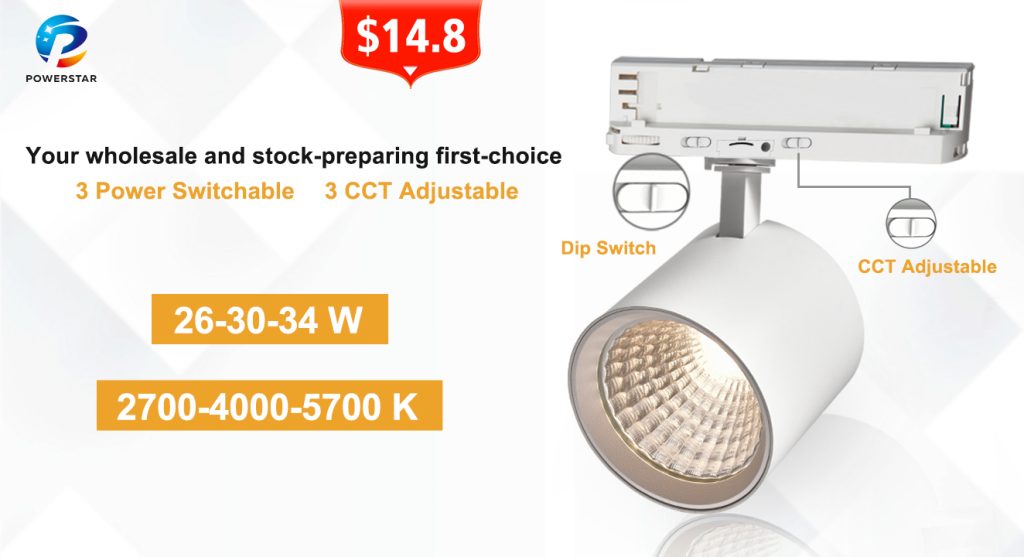The Invisible Profit Engine in Commercial Environments
By Powerstar

With advancements in LED technology, adjustable color temperature smart lighting systems have become essential in commercial spaces (e.g., retail stores, restaurants, hotels, offices).
In today’s competitive business landscape, subtle experiential details often determine consumer choices. Lighting, as a core element of spatial design, goes far beyond mere “illumination.”
This technology not only optimizes ambiance but also directly or indirectly enhances profitability. Below are the key advantages of adjustable color temperature lighting in commercial applications and its impact on revenue growth.
Dynamic Ambiance Creation to Elevate Consumer Experience
Color temperature (measured in Kelvin, K) directly affects human perception of an environment: warm light (2700K-3000K) evokes coziness and relaxation, while cool light (5000K+) conveys brightness and focus. With adjustable color temperature systems, businesses can flexibly adapt lighting to diverse scenarios:
- Hospitality Industry: Use cool light during breakfast to energize customers, then switch to warm light at dinner to create romance, prolonging dwell time and increasing average spending.
- Retail Spaces: Neutral light (4000K) in apparel zones ensures accurate color rendering, while warm light in luxury sections enhances product texture, stimulating purchase intent.
- Hotel Lobbies: Cool light during daytime projects professionalism; warm light at night fosters a sense of belonging, boosting customer loyalty.
- Profit Link: Studies show comfortable lighting can extend customer dwell time by 15%-20%, directly improving conversion rates and average transaction values.
Boosting Employee Efficiency and Reducing Labor Costs
In office settings, adjustable color temperature lighting aligns with natural circadian rhythms to enhance productivity:
- High color temperature (5000K-6500K) in the morning sharpens focus;
- Neutral light (4000K) in the afternoon reduces fatigue;
- Warm light (3000K) in meetings fosters collaborative creativity.
- Profit Link: Harvard research reveals circadian-aligned lighting boosts employee efficiency by 12%-15% while lowering error rates caused by fatigue, indirectly cutting management costs.
Energy Savings and Long-Term Cost Control
Adjustable color temperature LED lights consume only 30%-50% of the energy used by traditional lighting and last over 50,000 hours. Smart scene presets (e.g., “operational mode” or “energy-saving mode”) eliminate wasteful lighting, further reducing electricity bills.
Profit Link: A mid-sized supermarket adopting this system reported a 40% annual reduction in energy costs and 60% lower maintenance expenses, recouping installation costs within two years.
Multifunctional Spaces for Higher Revenue per Square Foot
Adjustable color temperature enables single spaces to serve multiple purposes:
Profit Link: Increased space utilization drives revenue per unit area, especially in high-rent commercial districts.
Enhancing Brand Differentiation and Premium Appeal
Adjustable color temperature systems embody innovation and personalized service. For example:
- Luxury hotels use smart lighting to deliver “tailored experiences,” strengthening brand recall;
- Healthcare facilities employ neutral light to convey professionalism and reassurance.
- Profit Link: Unique experiences foster customer loyalty and word-of-mouth referrals, driving long-term repeat business.
Conclusion: Adjustable Color Temperature—The Future Standard for Commercial Lighting
From elevating consumer experiences to optimizing operational costs, adjustable color temperature lighting is redefining commercial competitiveness.
Its core value lies in flexibility and precision: meeting diverse needs while balancing energy efficiency and experiential quality through data-driven control.
For businesses pursuing sustainable profits, investing in this technology is not just an upgrade—it’s a low-risk, high-reward strategic revolution.



